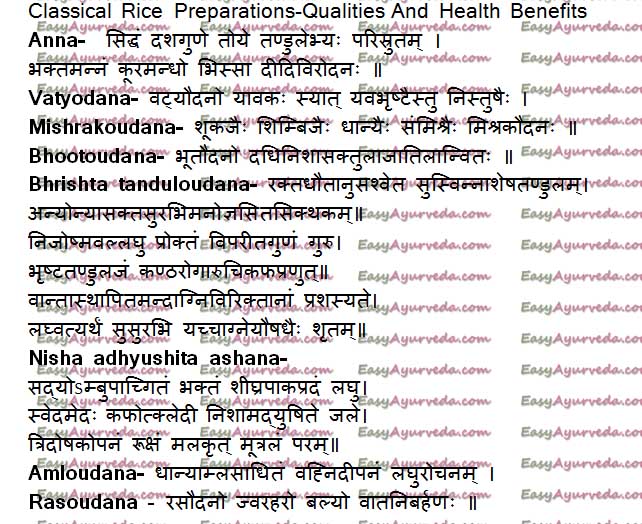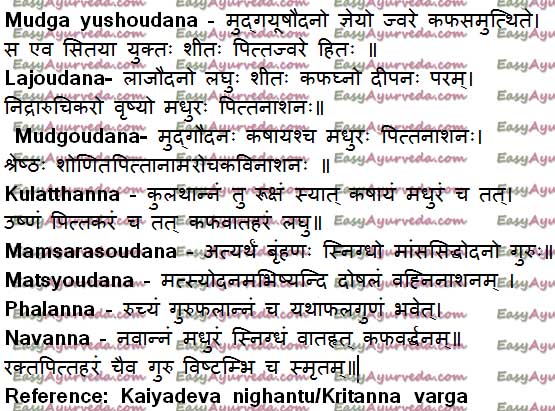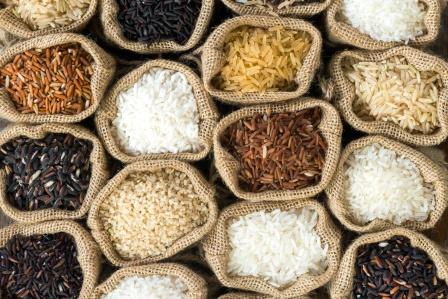Rice Combinations With Pulses, Vegetables, Grains, Soups
By Dr MS Krishnamurthy MD (Ayu) PhD.
Rice is preferred staple food of South India. Just like a day without chapati or roti cannot be assumed in North India, a day without rice is very hard to believe. Varieties of rice and rice preparations are practiced for breakfast, lunch as well as dinner. Other than the cooked rice various preparations can be found among the houses both in par boiled rice as well as white rice.
Following descriptions has classical references of varieties of rice preparation.
Table of Contents
Classical reference


Read related – Ayurveda Mahodadhi Dhanya Varga – Types Of Rice
Methods of rice and gruel preparation
Anna-
One part of rice (washed thoroughly with water) and 10 parts of water are taken together and boiled. Super-natant thin portion is drained out. The remnant solid portion is called Odana or Anna.
Bhakta, Anna, Koora, Mandha, Bhiossa, Deedivi, Odana, Ashana etc are synonyms of this.
Vatyodana-
Yava (barley) is de-husked and fried a little. Later it is cooked with water. The solid part obtained on draining is called Vatyoudana.
Mishrakoudana-
Mishra means mix. Shooka dhanya (rice varieties) and shimbi dhanya (pulses) are taken together and cooked well. This is called Mishroudana.
Mishraudhana is heavy for digestion, provide strength, good for heart, nutritive, carminative.
Bhootoudana-
While cooking Rice, if curd, turmeric, grain flour and sesame seeds are put together it is called Bhootoudana.
Bhrishta tanduloudana–
Rice is fried a little and cooked with sufficient amount of water. Such a rice is called Bhrishta tanduloudana. And it is good in throat disorders, anorexia, Kaphaja disorders etc.
This is recommended after Vamana-Virechana-Asthapana basti therapies. Also, this is good to patients who have chronic indigestion.
Read – Rice Water (Tandulodaka) Ayurvedic Preparation Method, Uses
Sruta odana–
rice on proper boiling, if decanted several times by adding hot water each time, it is called Sruta odana; such a rice becomes light for digestion. Also, this kind of rice is recommended in urinary disorders, urinary calculi, Vata disorders, anorexia etc. It is nutritive and diuretic in nature.
Apasruta oudana–
Boiled rice if taken without draining supernatant water portion is known as Apasruta odana. This is sweet, increase kapha, nutritive and heavy for digestion.
It acts as absorbant too. It is recommended in emaciating disorders and is a good spermatogenic.
Nisha adhyushita ashana–
Rice which is kept overnight (on boiling) and used on the next day, it increases sweating, aggravates fat tissues, and worsens Kapha (phlegm).
It increases all three doshas. Such a rice is dry and diuretic in nature.

Siddhoudana–
Rice cooked by adding vegetables, tubers, fruits, oil or ghee, milk, flesh, sour substances and pulses is called Siddhoudana.
It is energizer, good for heart, heavy for digestion, nutritive and bulk enhancing.
Shaka siddhanna –
Rice cooked with vegetables is dry, hot and scraping (decreases fat tissues) in nature.
Amloudana–
Rice cooked with sour gruel (kanji) is called Amla oudana. It is digestive, carminative, light for digestion and a good appetizer.
Rasoudana –
Rice cooked with meat soup is Rasoudana. It is balances vata and rejuvinative.
Mamsarasoudana –
Rice cooked along with meat or meat soup is unctuous, heavy for digestion, nutritive and spicy in nature. It is recommended in emaciation, chronic disorders and neuro muscular disorders.
Excess intake may cause constipation.
Ghola bhakta –
It is Rice cooked along with thin buttermilk (water added). It is cold in potency, sweet in taste, good for heart, carminative and digestive.
It is considered to be good in digestion, abdominal pain, mal absorption, hemorrhoids etc. It is nutritive and appetizer too.
Buttermilk
Buttermilk Rice – Takroudana –
Buttermilk and rice are taken together and cooked. It acts as appetizer, nutritive and carminative. This Takroudana is relieves fatigue, haemorroids etc.
Soups
Greengram soup with rice – Mudga yushoudana –
Rice cooked along with green gram soup is beneficial in kaphaja fever due to digestive and carminative effect. If it is taken along with sugar candy it pacifies Pitta fever.
Read related –Green Gram Remedies: Skin Detox, Energy Drink, Bowel Movement
Mudgoudana–
Rice cooked along with green gram or its soup is called Mudgoudana.
It is sweet mixed astringent taste and it pacifies pitta dosha.
It is recommended in bilious, high Pitta complaints and anorexia.
Lajoudana–
Parched rice is cooked well and obtained rice is called Lajoudana. It is light, cold, balances kapha, sweet, calms down Pitta dosha, and carminative.
It is beneficial in sleeplessness, anorexia, decreased sexual libido.

Anna varieties
Yavakanna –
Well cooked barley is slimy, aphrodisiac, sweet and heavy in nature.
It is recommended in gaseous tumors, fever, rhinitis, cough, urinary disorders and throat disorders.
Uddalakanna–
Uddalaka kind of rice obtained on cooking is called Uddalakanna. It is sweet, appetizer, pacifies vata and kapha in nature. It is recommended in urinary disorders, indigestion, thirst, vomiting etc.
Yugandharam –
It is dense, heavy for digestion, aggravates cough and dyspnea.
Trina dhanoudana –
Well cooked millets are light, appetizing and carminative in nature. But excess intake may increase Vata dosha.
This is good in breathlessness, splenic disorders, liver disorders and Gudagata vikaras like haemorroids, fissure, fistula etc.
Mashoudana –
Black gram mixed cooked rice is Mashoudana and it is aphrodisiac, heavy for digestion; but beneficial in Vata disorders.
Kulatthanna –
Rice and horse gram are taken in equal quantity and cooked well. This is called Kulattha-anna. It is dry, astringent mixed sweet taste, light and hot in nature. It is pacify kapha and vata too. It is beneficial in abdominal worms and breathlessness.
Read – Horse Gram Uses, Recipes, Dose, Side Effects
Vidalanna –
Vidalanna is prepared from de-husked pulses along with rice. It is sweet in taste, dry, aggravates vata and pitta. Its qualities depends on pulses added, generally it is appetizer.
Read – Ayurveda Mahodadhi: Legumes Green Gram, Chickpea, Peas
Pigeon pea rice – Adhakyanna –
Adhaki (Pigeon pea Cajanas cajana) is cooked along with red rice is called by this name. It balances kapha and pitta, heavy for digestion.
Matsyoudana –
Rice cooked along with fish is abhishyandi (blocks the channels or increases secretion). It aggravates all three doshas and declines digestive fire. Regular intake will vitiate blood and may cause skin diseases.
Read – Fish Benefits, Side Effects – Ayurveda Details
Rice combination with fruits – Phalanna –
Fruit added rice is appetizer, tasty, heavy and nutritive; this is recommended in children.
Interaction with medicines, supplements
Can this be used while taking Homeopathic medicine?
Yes. This product does not react with homeopathic medicine.
Can
this medicine be continued while taking supplements like multivitamin tablets,
Omega 3 fatty acids etc?
Yes. Generally, this product goes well with most
of the dietary supplements. However, if you are taking more than one product
per day, please consult your doctor for an opinion.
With western
medicines
Seek your
doctor’s advice if you are taking this product along with other western
(allopathic / modern) medicines. Some Ayurvedic herbs can interact with modern
medicine.
If both Ayurvedic and allopathic medicines are advised together, then it is
best to take Allopathic medicine first, wait for 30 minutes and then take the
Ayurvedic medicine.
Shashtika shaali
Shashtika shali anna –
Red variety of this special rice (got in 60 days duration of the crop- now extends for 70-72 days) if cooked and consumes it acts as a good nutritive, digestive and energizer. It is good for eyes; also it is beneficial in emaciating disorders as well as poisoning conditions.
Sweating treatment done with this type of rice is called Shashtika Shali Pinda Sweda
Navaanna
Fresh rice – Navanna –
Fresh rice if cooked (within a year of the crop), it is sweet, unctuous,balances vata, increases kapha, heavy and blocks the channels. But it is good for the patients who are suffering from the bleeding disorders.
Thus one should know the quality of Rice and use them according to the need, necessity and liking.
Contact Dr MS Krishnamurthy MD (Ayu), PhD










2 comments
Marcin
Indian stores in Canada do not have horse gram. It must be quite uncommon.
Paddy
Where do you live in Canada? If you are in Brampton or Etobicoke all
Indian stores have horse gram.